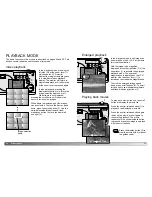
Exposure compensation must be set
before the image is captured. When
making adjustments to exposure, the
amount of compensation is shown at the
bottom of the LCD monitor. After the
setting is made, the shutter-speed and
aperture displays will indicate the actual
exposure. Because the exposure can be
adjusted in fine steps, the shutter speed or
aperture value displayed may not change.
When set to any value other than 0.0, the exposure-compensation
indicator and the degree of compensation will remain on the LCD monitor
as a warning.
29
28
A
UTO
-
RECORDING MODE
The camera exposure can be adjusted to make the final picture lighter or
darker by as much as ±2Ev in 1/3 increments. This function is only
available in the auto-recording mode.
Exposure compensation
Compose the picture on the monitor and
press one of the scroll buttons to
activate exposure compensation; the
camera exposure is locked. Changing
zoom or mode dial position will cancel
exposure compensation.
Set the degree of exposure-
compensation using the scroll buttons.
Changes to exposure are visible in the
live image. The exposure is locked until
picture is taken.
What is an Ev? What is a stop?
Ev stands for exposure value. The term stop comes from the name of
aperture plates used in early lenses. A change of one Ev or one stop will
adjust the exposure calculated by the camera by a factor of two.
Change in Ev
Change in stops
Adjustment to exposure
+2.0 Ev
+1.0 Ev
0.0 Ev
–1.0 Ev
–2.0 Ev
+2 stops
+1 stop
–1 stop
–2 stops
4X as much light
2X as much light
1/2 as much light
1/4 as much light
Calculated exposure
–2.0Ev
–1.0Ev
Calculated camera
exposure
Sometimes the camera’s exposure meter is deceived by certain
conditions. Exposure compensation can be used in these situations. For
example, a very bright scene, such as a snowy landscape or a white
sandy beach, can appear too dark in the captured image. Before taking
the picture, adjusting the exposure by +1 or +2 EV will result in an image
with normal tonal values.
In the example above, the dark water caused the camera to overexpose
the image making it bright and washed-out. By compensating the
exposure, detail is brought out in the leaves, and the stones and water
appear richer.
If the flash mode is set to autoflash, the flash will not fire. To use the
flash, set the flash mode to fill-flash.
If the LCD monitor is off, it will turn on automatically when exposure
compensation is active, but can be turned off if necessary.
Содержание DiMAGE E223
Страница 1: ...INSTRUCTION MANUAL E ...
















































